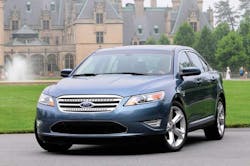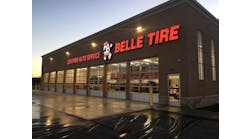Take a close look at the next late-model, mid-size sedan that rolls into your parking lot. Make note of the car’s tires. More often than not, you’ll find larger tires with a smaller aspect ratio and a higher speed rating — tires that perhaps 10 years ago would have been confined to the high performance or ultra-high performance categories.
Used to be, HP and UHP tires were strictly found on high-powered sports cars. Not anymore. Now, cars like the Honda Accord, Toyota Camry and other common sedans are rolling off the assembly line outfitted with 50-series to 55-series tires, some up to 17 inches in diameter.
“High performance is no longer as rare a designation as it used to be,” says Fred Koplin, director, marketing communications, for Yokohama Tire Corp. “There are simply more vehicles coming with tires that years ago would have been considered aftermarket upgrades. Now they’re standard.”
The proliferation of these tires at the original equipment level presents opportunities if you have the knowledge and expertise to steer customers toward suitable replacements.
That’s why it’s vital to understand why formerly exotic tire and wheel packages are becoming more and more common.
And it’s equally important that you know how to explain this trend to buyers. The idea is to put them in the right tire so they can drive away confident that they’ve made a smart investment.
Many different angles
“There’s no doubt performance is being pushed from a lot of different angles,” says Travis Roffler, director of marketing, Continental Tire North America Inc. (CTNA).
Increased vehicle sophistication is the reason, say tire company executives. This has driven the diameter of OE tires up while the sidewalls on OE tires have gotten smaller.
“The braking capabilities of cars are just so much better,” says Mark Richter, senior manager of dealer marketing, Falken Tire Corp.
“Most vehicles are coming with disc brakes so OEMs need more space inside the wheel. We’re seeing fewer 16-inch tires.” (For an in-depth, year-by-year look at the evolution of passenger tire sizes, see the chart on page 22.)
“Some cars have sport packages, as well. Take the Honda Accord; the base Accord comes with a four-cylinder engine and then there’s a V-6. Some of the V-6 Accords in the past have come with V-rated tires.”
“Technology is allowing us to make HP and UHP tires that are very well-rounded,” says Tom Gravalos, vice president of motorsports, marketing and OE sales, Pirelli Tire North America Inc. (PTNA). “And carmakers are in a position now to expand the placement of HP and UHP tires on vehicles. All of this is because of modern, sophisticated technology.”
“I think to some degree there are styling considerations in terms of wheel diameter size,” says Yokohama’s Koplin, “but I also think the OEMs are asking, ‘What can we do to improve handling? What can we do to improve braking?’
“They recognize that the tire is a very important component. If they want to achieve specific performance goals, tires are part of the equation.”
[PAGEBREAK]
Load index is key
There are several things to keep in mind when replacing OE tires that have HP/UHP dimensions and performance characteristics.
“Load index is a big topic,” says Richter. “You don’t want to under-load the capacity of the tires when you’re switching out.”
All of the safety add-ons that modern cars boast — including ABS, traction control and roll-over guards — make vehicles heavier.
Falken, PTNA and other tire manufacturers recommend mounting tires with the same load index as the OE tires. “Load index is determined by the car manufacturer,” explains Richter.
Plus-sizing and optional fitments are fine, says Gravalos. “Just make sure the weight-carrying requirements on the placard of the car are met by the tire. That’s crucial.”
As far as rim diameters are concerned, the trend toward extreme sizing seems to be topping out, says Bob Toth, director of products and innovation for Goodyear Tire & Rubber Co.
“The never-ending quest for bigger and bigger wheel diameters has maxed out. Twenty-one inches and higher is now truly boutique. That changes the lay of the land.”
UHP tires, he says, are still strictly defined. “It’s that middle segment that’s the gray area. Sizes are starting to overlap. Aspect ratios are morphing, as well. There are as many 55-series mass market tires as there are 55-series HP tires. You’ll even find 50-series tires coming on cars.”
Sticker shock diagnosis
It’s a simple recommendation: To maximize safety and maintain the specific performance characteristics of a vehicle, replacement tires should at least equal, if not exceed, the performance characteristics of the original tires.
However, this comes with a price tag — one that may be higher than what the average vehicle owner is expecting.
The result, very often, is an acute case of “sticker shock.”
According to PTNA’s Gravalos, most instances of sticker shock can be attributed to “the infrequency of the tire purchase.”
He compares tires to water heaters, asking “How much should a water heater cost? I don’t know. I bought one 10 years ago, but I’ve forgotten what it cost. Tires are more frequently (purchased) than water heaters, but they’re not something you buy all the time.
“Combine that with the advertising that takes place in this industry,” he continues. “Most of it is highlighting a very low, entry-level tire cost. Nobody ever advertises they have a premium tire on sale for only $299 each! So that’s going on in people’s minds, too.
[PAGEBREAK]
“And quite frankly, tires are not a favorite thing for consumers to spend money on. So here you have a three-year-old vehicle, you’re still making payments on it, and you have to put your first set of tires on. You thought you were going to spend $500 on a set of tires and it turns out to be $900. People don’t like it.”
Can sticker shock be treated? Yes, says Yokohama’s Koplin. But it takes education and salesmanship.
Customers need to know that “the tires they can buy today are better than the tires they bought years ago. The end result for the customer is they get a higher performing tire and a better all-around experience.”
Dealers must let consumers know that HP and UHP tires cost more “because of all the research and development the major brand manufacturers put into developing them... more development into compounding, construction and things that makes the tires safer.”
You can even break down costs associated with the tire’s components.
“Because it’s an ultra-high performance tire, the sidewalls need to be reinforced,” says John Wu, assistant product manager, Maxxis International — USA.
“The tire is typically heavier and the compound is softer. Most likely, if it’s a grip-oriented product, it contains more carbon black, and carbon black is more expensive.
“You also have higher tensile steel. There’s just more to it.”
Also promote continuity of performance, says Gravalos. “If you buy a really great automobile but you’re unwilling to spend the money for a really good set of tires, all of that great handling and all of that great performance is for nothing.”
“The key to minimizing sticker shock is to offer the consumer a range of viable options,” says Richard Purol, vice president of Treadways.
“Some people will insist on buying the exact tire that came on their vehicle, so most dealers keep relationships with those brands.
“We feel most consumers care more about true value. They want tires that perform at or beyond the level of the OE brand, but they don’t want to pay an arm and a leg.”
[PAGEBREAK]
More treatment tips
When replacing low-profile, large-diameter OE tires, it’s important to qualify the customer, according to Goodyear’s Toth.
“Typically, the OEM is less concerned about the tread wear of a tire, and even ride comfort. They’re going to focus on responsive handling.
“It’s very important to ask the customer, ‘What do you like and dislike about your OE tire?’ This makes the guy behind the counter even more important!”
And don’t forget to discuss tire maintenance, says Koplin.
“You can even go one step further and say, ‘Maintaining tire pressure is important for the longevity and performance of your tire. I suggest you check your air pressure once every two weeks. Here’s a tire gauge I want you to have; it has my store’s name and phone number on it.’
“Or you can say, ‘By all means, anytime you drive by my store, let me give your tires a quick look. I want you to have these tires a very long time.’
“It’s an opportunity to coach the customer. The tire dealer is the person the customer looks to first and is the person who is best-positioned to foster that relationship.”
The proof, according to CTNA’s Roffler, is when the vehicle owner drives off with a new set of replacement tires.
“I think there can be buyer’s remorse if the customer buys a sub-par tire. I think that’s called out pretty quickly on the first rainy day.”
“That’s the difficult thing about being successful in this business,” says Falken’s Richter. “How do you make the customer happy so he’ll come back and buy more sets of tires?” ■
[PAGEBREAK]
Categorically speaking -- Passenger tire categories, according to Yokohama
How many passenger tire categories are there? Where do high performance and ultra-high performance tires fall? Yokohama Tire Corp. recognizes the following categories:
1. Max performance (includes W-rated tires used for track events but also good for street use, according to Yokohama officials.)
2. Ultra-performance (includes Z-, W- and Y-rated tires). “This is where Porsche and some BMWs fit,” says Dan King, Yokohama’s vice president of sales and marketing.
3. Ultra-performance all-season (still includes Z-, W- and Y-rated tires). “This has been a tough category for manufacturers. Lots of people have had a tough time designing an all-season tread for this category.”
4. Traditional high performance (includes H- and V-rated tires). “This category will probably splinter because vehicles have changed. We have much more sophisticated vehicles.”
5. Touring (includes T-rated tires).
6. Broad-line (includes S-rated tires, or “what we’ve always considered to be passenger tires,” says King).
Yokohama has created what it calls a brand new category, “Grand Performance,” with the launch of its new Avid ENVigor high performance tire, available March 1. The ENVigor “is beyond the traditional high performance tire,” says King, who adds that it delivers all-season performance, long tread life, fuel efficiency and comfort.
According to King, Grand Performance fits between the ultra-high performance and traditional high performance categories listed above. Yokohama will use ENVigor to promote Grand Performance.
What to stock? Different specs add to complexity
The proliferation of HP and UHP tires at OE “is all about performance,” says Travis Roffler, director of marketing, Continental Tire North America Inc.
However, when it comes to tire performance, vehicle manufacturers and replacement tire buyers often want different things, he explains. “Whereas the OEMs are looking for rolling resistance and other attributes, replacement customers may be looking for wet traction and tread life — those kinds of things that aren’t as high of a priority with the OEMs.”
As a result, the inventory complexity for tire dealers can be enormous. To wit: Continental, he says, “can have a particular size, P225/45R17, in five (different) tires because one is for BMW, one is for Mercedes, one is for Audi, etc. They all have a different make-up. It could be construction, tread design — they all have different needs.”



